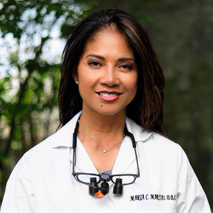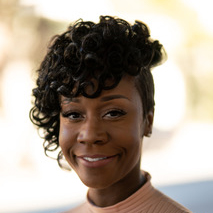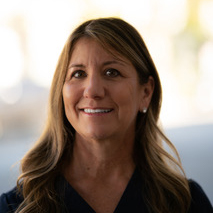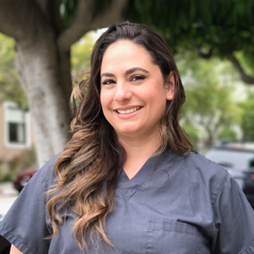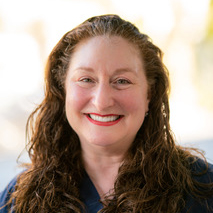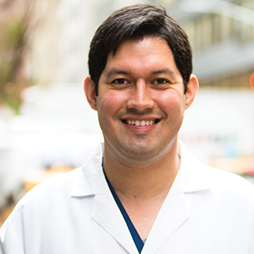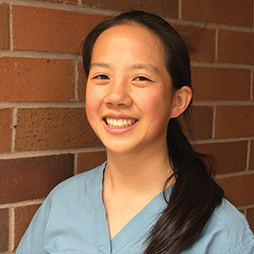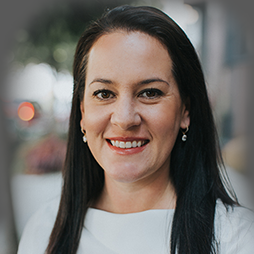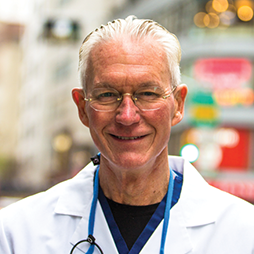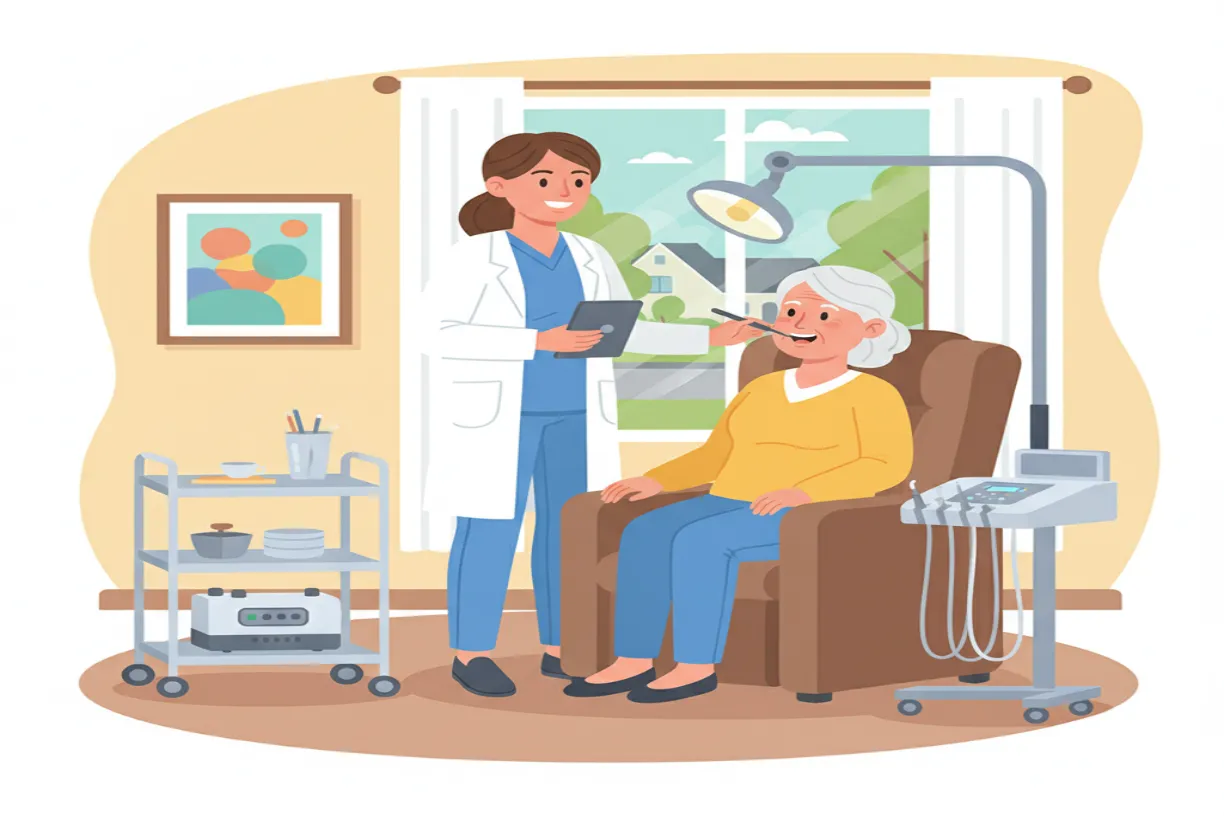
09 Oct Not All Onsite Senior Dental Care is Created Equal
Oral health is crucial to overall well-being, but this fact becomes even more pronounced as we age. For residents in senior living communities, accessing high-quality dental care has been a longstanding logistical challenge. The rise of mobile dentistry, however, removed these barriers. Onsite dental services, often facilitated by Registered Dental Hygienists in Alternative Practice (RDHAPs), bring essential care directly to residents, eliminating the stress and difficulty of in-office appointments. Yet a recent conversation with a highly experienced RDHAP brought a crucial issue to light: the vast difference in the quality of care among mobile dental providers. She shared a “night and day” experience, first with a company that provided substandard service and then with a practice that exemplified the best in clinical excellence and patient care. Her story is a powerful reminder that when it comes to the health of your residents, the provider you choose matters immensely.
Understanding the Role of the RDHAP
RDHAPs stand on the frontlines when it comes to onsite portable dentistry, but they aren’t just dental hygienists. They’re specially licensed professionals who’ve undergone additional training and have met specific requirements to provide care outside of a traditional dental office.
Their unique licensure allows them to work in settings like residential care facilities, schools, and private homes, bringing preventative oral health services to populations with barriers to access. These services are the bedrock of senior dental wellness through a variety of services.
- Prophylaxis (Teeth Cleaning): Removing plaque and tartar buildup that can lead to gum disease and decay.
- Periodontal Maintenance: Providing specialized cleanings for residents with a history of gum disease to prevent its progression.
- Oral Health Screenings: Identifying potential issues such as cavities, oral lesions, and signs of oral cancer.
- Patient Education: Offering personalized instruction on proper brushing, flossing, and denture care to residents and their caregivers.
An RDHAP is an indispensable asset. They are the consistent and familiar face who builds trust with residents, understands their unique medical histories, and becomes the primary line of defense in maintaining their oral health. However, the RDHAP is most effective when they are part of a collaborative, comprehensive clinical team. A premier dental group supports them with robust systems, advanced technology, and direct oversight from a supervising dentist. The RDHAP’s findings must be reviewed by a dentist who then creates a definitive diagnosis and comprehensive treatment plan. This team-based approach is the first sign of a high-quality provider.
Communication and Professionalism as a Clinical Indicator in Senior Dental Care
So let’s circle to the RDHAP’s frustrating initial experience, which we opened this post with. Her concerns began before she even picked up an instrument. It actually started with a phone call. She described the customer service at the first company as dismissive and disorganized, creating immediate doubt and apprehension. When she later contacted a different provider, the experience was profoundly different: the phone was answered by a knowledgeable and empathetic coordinator who listened, understood the needs of the community, and scheduled services efficiently.
This is not a minor detail. The way a mobile dental provider communicates is a powerful indicator of their overall philosophy of care.
Red Flags in Provider Communication
- Difficulty Reaching Someone: Constant voicemails, unreturned calls, or long hold times.
- Dismissive or Rushed Interactions: A team that doesn’t take the time to answer questions from facility staff or residents’ families.
- Disorganized Scheduling: Frequent cancellations, confusion about appointment times, or lack of proactive communication.
- Vague Information: An unwillingness or inability to clearly explain their services, procedures, or billing practices.
Hallmarks of an Excellent Provider for Senior Dental Care
- A Dedicated Point of Contact: You should have a consistent care coordinator who knows your facility, your residents, and your needs.
- Respectful and Patient-Centered Communication: The team should speak to staff, residents, and families with respect, empathy, and patience, taking the time to ensure everyone is comfortable and informed.
- Proactive and Clear Scheduling: A well-organized provider will work closely with your activities or wellness director to create a seamless schedule that minimizes disruption for residents and staff.
- Transparent Processes: From the first call, they should clearly articulate their clinical process, what to expect during the visit, and how they handle billing and insurance.
Think of the initial phone call as a clinical assessment of the provider. If they are flustered, chaotic, uncommunicative, and unprofessional in their administrative practices, it’s a strong warning sign that these same deficiencies may plague their clinical operations. A group that values excellence will ensure that every touchpoint, from the front office to the clinical team, reflects their commitment to quality.
The Non-Negotiable Role of Diagnostic X-Rays in Senior Dental Care
Perhaps the most alarming part of the RDHAP’s story was this: the first dental provider did not take any X-rays. They performed a cursory cleaning and provided minimal treatment, without ever looking beneath the surface of the gums. This is clinically negligent.
A visual examination or a simple cleaning without dental radiographs (X-rays) is like trying to diagnose the condition of a house by looking only at the paint on the walls. So much of what can cause pain, infection, and systemic health issues in seniors is invisible to the naked eye.
X-rays Are Essential
Seniors are particularly vulnerable to a host of complex dental issues that can only be accurately diagnosed with radiographs.
- Bone Loss: Periodontal disease, a common ailment in seniors, causes the bone that supports the teeth to deteriorate. X-rays are the only way to assess the extent of this bone loss and determine the stability of the teeth.
- Interproximal Cavities: Decay often begins in the tight spaces between teeth, completely hidden from view. Without X-rays, these cavities can grow unchecked until they cause significant pain or require a root canal or extraction.
- Abscesses and Infections: A dental abscess is a pocket of pus caused by a bacterial infection at the root of a tooth. It can be painless at first but is a serious condition that can lead to systemic infection. An X-ray is crucial for identifying these hidden infections.
- Impacted Teeth: Teeth that have failed to erupt properly can cause pain, cysts, and damage to adjacent teeth.
- Issues Under Existing Dental Work: X-rays allow a dentist to see the health of the tooth structure underneath crowns, bridges, and fillings to ensure they are not failing.
A provider who touts comprehensive care without taking X-rays is not providing care at all—they’re instilling a false sense of security. Today, with advanced portable digital X-ray technology, capturing these essential images is safe, fast, and comfortably performed right in the resident’s room. The radiation exposure is minimal, and the diagnostic benefit is immeasurable.
When vetting a mobile dental provider, your first clinical question should be, “Do you use portable digital X-rays for your diagnostic process?” If the answer is no, or if they claim X-rays aren’t necessary for routine visits, you should immediately end the conversation and seek a provider who prioritizes a complete and accurate diagnosis.
What Gold-Standard of Senior Dental Care Looks Like
The RDHAP’s relief and confidence were restored when she worked with the second provider. The difference was the thoroughness of the entire process, from the initial examination to the final treatment plan. This is the “day” to the other provider’s “night.”
So, what should you and your residents expect from a high-quality on-site dental visit?
Comprehensive Medical History Review. The clinical team should conduct a thorough review of each resident’s medical history, including all medications. Many medications cause dry mouth (xerostomia), which significantly increases the risk for cavities, and other health conditions like diabetes can have a profound impact on oral health.
- Full-Mouth Charting and Periodontal Evaluation: This is far more than a quick look. The hygienist and dentist should measure the “pockets” around each tooth to assess for gum disease, check for tooth mobility, and note any existing dental work and areas of concern.
- Oral Cancer Screening: A vital and potentially life-saving step. The clinician should carefully examine the tongue, cheeks, palate, and other soft tissues for any abnormalities.
- The Diagnostic X-rays: A full set of necessary radiographs should be taken to provide a complete picture of the resident’s oral health.
- A Definitive Diagnosis and Co-Developed Treatment Plan: Based on all the gathered information, the supervising dentist (who may be onsite or reviewing the data remotely via teledentistry) makes a definitive diagnosis. The treatment plan is then developed and discussed in detail with the resident and their family or power of attorney. The plan should be clear, with all options explained.
- Professional and Meticulous Clinical Care: Whether it’s a cleaning, a filling, or a denture adjustment, the care should be delivered with skill and compassion, ensuring the resident is comfortable throughout the process.
A provider who follows these steps demonstrates a commitment to treating the whole person, not just cleaning their teeth. They build confidence and trust by being meticulous, communicative, and transparent. It is this level of thoroughness that gives onsite professionals, like the RDHAP from our story, the confidence to know their patients are in the best possible hands. And in case you were wondering about the provider the RDHAP praised, that was us at House Call Dentists.
Choosing Your Partner Wisely
Not all dental house calls are equal. The health and comfort of your residents are too important to leave to chance. As you evaluate potential mobile dentistry partners, use this checklist to ensure you are selecting a group that represents the gold standard of care.
- They are a team. They don’t just provide a hygienist; they provide a comprehensive clinical solution with a supervising dentist who makes the final diagnosis and oversees all treatment.
- They are excellent communicators. From the very first phone call, they are professional, responsive, respectful, and organized.
- They use modern diagnostic technology. They utilize portable digital X-rays as a standard and non-negotiable part of their diagnostic process for every new patient.
- They are thorough. Their examinations include a full review of medical history, periodontal charting, and an oral cancer screening.
- They are transparent. They provide clear, easy-to-understand treatment plans and are upfront about all procedures and costs.
- They are collaborative. They see themselves as a partner to your community, working seamlessly with your staff and keeping families informed every step of the way.
Your residents have spent their lives working, caring, and contributing. Now, it is our collective responsibility to provide them with the best care possible. By demanding this higher standard from your on-site dental providers, you are not just protecting their smiles; you are safeguarding their health, their comfort, and their dignity.
Why not learn more about high-quality senior dental care and house calls?> Or schedule a consultation with our team.
